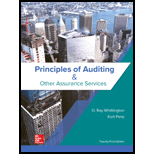
Explain the circumstances that may lead to identify the understatement of assets as a significant audit risk.
Explanation of Solution
Audit risk:
The purpose of the audit is to provide an independent and professional opinion on the fairness and accuracy of the financial statements of the company. The auditor of the company is engaged in the analysis of the financial statement to perform the
Audit risk arises when the auditor is not able to find the misstated information in the financial statements of the company. When the financial statement possesses the material misstatement even after the auditing, then it is regarded as an audit risk.
Explain the circumstances that may lead to identify understatement of assets as a significant audit risk:
Following are the circumstances that may lead to identify the understatement of assets as a significant audit risk:
- The management of the company could understate the assets in order to save the income tax. The company need to pay less income in case of decreased asset value.
- The management of the company could have recorded the asset at the discounted amount at the time of purchase.
- The assets could be acquired by the illegal means so the management of the company does not want to show it in the books and the overall value of the assets is understated.
Thus, the management of the company may understate the asset for paying lesser income tax, could have recorded the asset at the discounted amount at the time of purchase and the asset is acquired by the illegal means are the circumstances that may lead to identify understatement of assets as a significant audit risk.
Want to see more full solutions like this?
Chapter 10 Solutions
EBK PRINCIPLES OF AUDITING & OTHER ASSU
- Tetris Technologies purchased laboratory instruments at the beginning of the year for $68,000. The equipment has an estimated residual value of $4,000 and an estimated useful life of 5 years. Determine the second-year depreciation using the straight-line method.arrow_forwardGeneral accountingarrow_forwardCould you help me solve this financial accounting question using appropriate calculation techniques?arrow_forward
 Auditing: A Risk Based-Approach to Conducting a Q...AccountingISBN:9781305080577Author:Karla M Johnstone, Audrey A. Gramling, Larry E. RittenbergPublisher:South-Western College Pub
Auditing: A Risk Based-Approach to Conducting a Q...AccountingISBN:9781305080577Author:Karla M Johnstone, Audrey A. Gramling, Larry E. RittenbergPublisher:South-Western College Pub Auditing: A Risk Based-Approach (MindTap Course L...AccountingISBN:9781337619455Author:Karla M Johnstone, Audrey A. Gramling, Larry E. RittenbergPublisher:Cengage Learning
Auditing: A Risk Based-Approach (MindTap Course L...AccountingISBN:9781337619455Author:Karla M Johnstone, Audrey A. Gramling, Larry E. RittenbergPublisher:Cengage Learning

